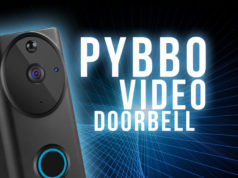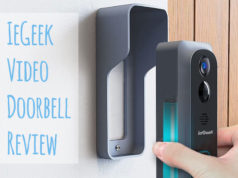If it’s time to beef up the home security and that old alarm is giving more false signals and driving your neighbours crazy, you’ll likely be looking at getting a decent smart alarm. If you’ve got a pooch or a puss on the premises, it’s essential to check you’re getting a pet-friendly smart alarm too.
In this guide, we’ll cover everything you need to know to get the right gear and keep your home (and pets) safe and get a pet-immune system.

- In the kit: 9-Piece Kit (Alarm Siren, Door/Window Sensors, Remotes, Motion Sensor, Keypad)
- Pet friendly: Yes, supports pet-immune motion detectors
- Subscription required: No, No contracts and No subscription fee
- Cameras: Not included in kit

- In the kit: 2 rechargeable emergency buttons, detailed instruction manual.
- Pet friendly: Designed with pets in mind; avoids false alarms triggered by pets.
- Subscription required: No fees, lifetime returns and exchanges offered.
- Cameras: Not included in this package.

- In the kit: Yale HSA6410 Premium+ Home Alarm Kit, including 4 AAA batteries.
- Pet friendly: Three adjustable settings for pet movements.
- Subscription required: Optional monitoring subscription.
- Cameras: HD Indoor Security Camera included in selected kits.

- In the kit: 5 Piece Kit, Siren, Keypad, Batteries included
- Pet friendly: Sensors differentiate between pets and intruders
- Subscription required: No monitoring fee, no contract
- Cameras: Not included in the kit

- In the kit: Base station, 2 remotes, 9 contact sensors, 1 power adapter, 1 charging cable.
- Pet friendly: Accommodates pets effectively in security setup.
- Subscription required: No ongoing subscription required.
- Cameras: Not included in the kit.

- In the kit: Alarm hub, siren, sensors, and batteries.
- Pet friendly: Anti-pet PIR technology included.
- Subscription required: No, operates with Wi-Fi/GSM.
- Cameras: Not included or compatible.

- In the kit: 4 Arlo Pro 3 Cameras, SmartHub, Mounts, Cables
- Pet friendly: Yes, with AI image analysis
- Subscription required: Yes, for full functionality
- Cameras: 4x Arlo Pro 3 with 2K HDR

- In the kit: Siren, 2 Door/Window Sensors, 2 Remote Controls, PIR Motion Detector
- Pet friendly: Yes, with accurate monitoring to avoid false alarms
- Subscription required: No, operates as a standalone system
- Cameras: Not included in the kit

- In the kit: 1 Alarm Siren, 5 Door/Window Sensors, 2 Remote Key Fobs
- Pet friendly: Doesn't get triggered by pets under 1 CM distance
- Subscription required: No Subscription Fee
- Cameras: Not included in the kit

- In the kit: 1 SBS50 base station, 3 XS01-M smoke alarms, 1 power adapter, 1 power cable
- Pet friendly: Advanced sensors minimise false alarms from pets
- Subscription required: No monthly fees for basic features
- Cameras: Compatible with X-Sense cameras, sold separately
What is a smart pet alarm?

Smart alarms are modern home security systems comprised of a huge array of parts, each communicating with each other using networks such as WiFi and Bluetooth. They’re wire-free, reliable and there are some huge brands in the market such as Yale, Ring and Eufy.
One of the main draws with this kind of alarm is they connect with smart devices like tablets or smartphones to give you notifications, alerts and allow you to do things like disabling the alarm.
The main idea is you’ll place a series of sensors around your home and a siren preferably on the front of your property to let would-be intruders know you’re ready for them and to act as a deterrent. The main sensors used in smart alarms are:
- Infrared motion detectors (PIR sensors) – The modern version of the sensors that have been used in UK home alarms for decades. Smart PIR sensors are completely wireless and can have up to a whopping 200m range. More on these and how they work with pets in a second.
- Door and window opening sensors – These are simple two-part switches that you place on any conventional door or window and will trigger an alarm if they’re moved apart.
- Safety sensors such as fire and flood detectors – One great thing about smart alarms is they’re quick and easy to expand by plugging in new modules such as smoke alarms, CO2 and other sensors.
Adjusting sensitivity levels on your smart alarm to your pet’s requirements
Depending on which make of smart alarm you get, there’s normally a way to tune the sensors to however large your pet is. The Ring smart alarm, for example, has 3 sensitivity levels that allow it to ignore pets of different sizes.
Do I need to get a security company to fit my pet smart alarm?
Getting someone out to install an alarm can be a costly business and the other problem is you’re tied to them if anything goes wrong, or you want to update a sensor. Modern smart alarms are far more user-friendly compared to the older systems and are much easier to set up yourself.
You don’t need to hire a company to get your home secured but you may need to hire an electrician to do something simple like wiring in the siren if it’s one that requires a wired power supply. This is really the only part you might need help with.
Setting up the alarm, connecting it to your Wifi and adding the pet-friendly sensors around your home is something anyone can do in 2025.
How do pet-friendly PIR pet alarms work?

Smart alarms that you can use with pets have sensors that aim to differentiate between a human and an animal.
It’s unlikely your cat or dog will be opening a door or window so those sensors aren’t a problem. Dogs can show up on the PIR sensors and it’s this component of the smart alarm that needs to be able to tell if it’s a pet or a human.
Comparing the heat from your dog’s mass
Pet safe PIR sensors are able to detect the ‘mass’ of your pet and will only trigger the alarm if it’s above a certain weight limit. This varies between different brands of alarms but is usually around 25kg – 35kg.
Pet-friendly alarms aren’t anything new and this was technically possible prior to smart alarms. Pre-smart sensors could be set to not trigger the alarm and could be tweaked but they were unreliable.
We have a chubby chocolate labrador that likes to sleep walk and set off our old non-smart alarm a number of times during the night. Queue my legging it downstairs in a panic, shutting off the siren ASAP. Stressful to say the least.
Using height zoning to determine if it is a pet or an intruder
Another common system that pet-friendly alarms use compared to regular ones is that they can ignore activity under a certain floor height.
While it’s not perfect (dogs can jump up on a counter if they smell something tasty, or climb up on the sofa, for example) it’s an additional way for the alarm to tell the difference between mutt and a burglar.
You can also keep an eye on your dog or cat with a smart alarm

Another key thing with smart alarms you can use with your pets is how you can use them in conjunction with your smartphone and if you’ve got cameras installed in your home kit, there’s a number of things you can do:
- Check the pets are OK
- Turn off any false signals
Alternatives to PIR sensors for pet alarms
If you’ve got a larger dog like a St. Bernards or a Rottweiler, and you’re sure you’re going to have problems with them triggering your alarm when you’re not in your property, there are still some options you can go for in your new smart alarm.
Just using door and window sensors
As burglars don’t generally come in through the ceiling and digging through walls is rare, tagging your windows and doors with sensors will have a similar effect to PIR sensors, without the risk of a dog setting off the alarm when you’re not around.
Broken glass sensors are also available but the window and door opening sensors are cheap, easy to attach and very reliable.
Using outdoor sensors and floodlights
There are some excellent security lights you can get for outside your property. Obviously, these don’t trigger the alarm, but they can act as a great deterrent for burglars, send notifications to your phone of any activity and light up the property when they detect motion.
Using cameras rather than PIR sensors

You can also get smart cameras that are able to differentiate between an animal and a burglar. Short of wearing a dog costume and crawling across your living room floor (what a terrifying thought!) an intruder won’t be able to enter but your pets will be able to roam around.
Using smartphone alerts prior to the alarm going off
You can also give yourself a bit of breathing room by setting your smart alarm to sent an alert to your phone prior to setting off the screeching alarm. This can give you a bit of time to check things are OK and that it’s just the dog.
Will cats set off a PIR alarm?
Unless your cat has been getting stuck into a bit too much trifle, it’s unlikely it will have the mass and body heat to set off a PIR alarm, smart or not. Having said that, I could swear my Mr Tibbs set off our alarm one day jumping around in the kitchen!
There is one issue with cats, however, and that is if they climb above a certain height. A cat going up a curtain might do the trick and set your alarm off, leaving you wondering what happened.
Based on what I’ve experienced and read from other users, it’s very unlikely you’ll have any issues with your cat triggering an alert on any modern smart home system.
What are some good pet-friendly smart alarms?
There are a number of good smart alarms with pet-friendly sensors up for sale today. Here are some of the ones we’d recommend.

Grsico Door Alarm System
Sturdy, reliable, and pet-immune, the GRSICO alarm system is a top choice for homeowners with pets, thanks to its easy integration and no subscription fees.
Check Latest PriceWhat we liked about the Pet Friendly Smart Alarm System:
It offers budget-friendly installation, easy setup, and efficient operation, making it a practical choice for home security.
The loud alarm and flexible control options, including smartphone compatibility, ensure reliable protection and convenience.
What we didn't like about the Pet Friendly Smart Alarm System:
While the system excels in various aspects, it does have limited expansion options, and the speaker sound may diminish over distances, which could be improved for a more comprehensive experience.
How does it compare to similar smart alarm systems?
The Pet Friendly Smart Alarm System stands out for its pet-friendly features, operational flexibility, and budget-friendly installation, making it an attractive option for those looking for a reliable and convenient home security solution.
Verdict: Is it worth a buy?
The Pet Friendly Smart Alarm System offers an easy and budget-friendly installation, loud and flexible operation, making it an ideal choice for homeowners seeking a reliable and convenient security solution.
- Cost-effective: Reasonably priced with no ongoing subscription costs.
- User-friendly installation: Simple setup with 3M stickers and rechargeable batteries.
- Operational versatility: Controlled via keypad, remotes, and a smartphone app.
- Powerful siren: Loud enough to alert neighbours with adjustable duration.
- System expandability: Supports up to 20 sensors and 5 remotes/keypads.
- Limited expansion options: No additional sensors or keypads available for purchase.
- Speaker limitations: Volume decreases over distance, affecting audibility.
- Additional installation materials: Extra pads required for proper sensor alignment.

Daytech Tuya WiFi Smart SOS Call Button
Sturdy, reliable, and offering immediate alerts, ideal for those caring for pets or relatives, enhancing safety without subscription fees.
Check Latest PriceWhat we liked:
The Pet Friendly Smart Alarm system is designed with user convenience in mind. It offers an easy setup process, allowing for quick installation and operation. This simplicity is especially beneficial for individuals who may not be tech-savvy or for caregivers looking for hassle-free solutions.
The system provides peace of mind, offering reassurance to pet owners, caregivers, and elderly individuals. It acts as a reliable alert system, allowing for quick communication and assistance when needed, which can be crucial in emergency situations.
Notably, the Pet Friendly Smart Alarm is effective for non-verbal individuals, making it particularly helpful for those who have difficulty communicating verbally. This inclusive feature caters to a diverse range of users, ensuring that everyone can benefit from the system's functionality.
Additionally, the system has been reported as helpful for dementia patients, with users sharing positive experiences regarding its usability and effectiveness in catering to the specific needs of individuals with dementia.
What we didn't like:
While the Pet Friendly Smart Alarm offers various benefits, it is dependent on WiFi for optimal functionality. This reliance on WiFi may lead to potential issues if the mobile device is not connected to a reliable WiFi or 4G network, affecting the system's reliability.
Some users have expressed concerns about the subscription cost for SMS alerts, which could be perceived as an additional expense. Additionally, the limited sound choices have been a point of dissatisfaction for some users, who may desire a wider range of sound options for alerts.
Furthermore, certain users have encountered pairing issues with specific components of the system, highlighting potential technical challenges that may arise during setup and use.
How does it compare to similar Smart Alarm systems?
Compared to similar smart alarm systems, the Pet Friendly Smart Alarm stands out for its pet-friendly features and effectiveness for non-verbal and dementia patients. However, its dependency on WiFi and limited sound options may be areas where competing products offer more robust solutions.
Verdict: Is it worth a buy?
The Pet Friendly Smart Alarm offers ease of use and peace of mind, catering to non-verbal and dementia patients. However, potential drawbacks, such as dependency on WiFi and limited sound options, should be considered. Overall, for pet owners and caregivers seeking a user-friendly alarm system with specific inclusivity features, the Pet Friendly Smart Alarm is worth considering.
- Easy setup and use: Users appreciate the straight-forward installation and operation.
- Reassurance: Offers peace of mind, particularly for caregivers and the elderly.
- Effective alerts: Quick communication and assistance facilitated by the system.
- Non-verbal friendly: Assists those who struggle with verbal communication.
- Dementia support: Reports of positive impact for dementia patient care.

Yale HSA6410 Premium+ Home Alarm Kit
Sturdy, reliable, and tailored for animal lovers. The Yale HSA6410 Premium+ offers seamless integration with pets, ensuring home security without false triggers.
Check Latest PriceWhat we liked:
The easy installation process was a standout feature, making it a quick and straightforward setup for users. Additionally, the affordable price point makes it a cost-effective solution for home security. The pet-friendly design offers three options to accommodate pets' movements, and the user-friendly interface provides a simple and intuitive programming experience.
What we didn't like:
Despite its strengths, some users may find the options for pet settings restrictive, limiting the customization potential. Another potential downside is the loudness of the alarm, which could be disruptive to sensitive pets.
How does it compare to similar Smart Alarms?
Compared to other smart alarm systems, the Pet Friendly Smart Alarm stands out with its specific pet-friendly settings. However, the limited customization and loud alarm may be areas of concern for some users.
Verdict: Is it worth a buy?
In summary, the Pet Friendly Smart Alarm offers easy installation, affordability, and user-friendly programming. However, users should be aware of the limited customization options and the potential for a disruptive alarm, especially for sensitive pets. Overall, this product is suitable for pet owners seeking a reliable and pet-friendly home security solution.
- Easy installation: Quick to set up without professional help.
- Affordable price: Cost-effective, providing good value for the investment.
- Pet-friendly: Adjustable sensitivity to accommodate pets.
- User-friendly interface: Easy to understand and navigate.
- Companion app: Smartphone compatibility for remote monitoring.
- Limited customization: May not meet the needs of those requiring advanced settings.
- Loud alarm: Volume could be stressful for sensitive pets.

Yale YES-ALARMKIT Essentials Alarm Kit
Sturdy, reliable, and wireless for effortless installation. Perfect for homeowners seeking a secure, no-contract alarm system that's considerate of pets.
Prices checked: 15th December, 01:14:06
What we liked:
The easy installation process and pet-friendly sensors were standout features, enhancing the overall user experience. The system's compatibility with smart home devices further added to its appeal, providing a comprehensive and integrated security solution.
Moreover, the inclusion of a backup battery and a user-friendly app design contributed to the system's reliability and ease of use. The loud siren volume was noted as a strong deterrent to potential intruders, underlining the system's effectiveness in enhancing home security.
What we didn't like:
While the system received praise for its pet-friendly features, some users reported limitations in the size of pets that the system could reliably ignore, and occasional false alarms triggered by pet movements were a concern for a few.
Subscription costs for professional monitoring and constraints in the number of pet-friendly zones that could be set up were highlighted as areas for improvement. Furthermore, a few encountered challenges in integrating the system with certain smart home devices, impacting its seamless functionality.
How does it compare to similar Smart Alarms?
Compared to alternative smart alarm systems, the Pet Friendly Smart Alarm distinguishes itself with its comprehensive pet-friendly features and seamless integration with other smart home devices. While it offers reliable monitoring and customizable alerts, it could benefit from addressing the limitations in pet size and occasional false alarms.
Verdict: Is it worth a buy?
In summary, the Pet Friendly Smart Alarm presents a compelling option for pet owners seeking a comprehensive and integrated home security solution. Despite some limitations, its easy installation, pet-friendly features, and seamless integration with smart home devices make it a worthwhile investment for those prioritizing the safety of their pets and homes.
- Easy setup: The alarm kit is praised for its straightforward and wire-free installation process.
- Pet-friendly sensors: The system is adept at distinguishing pets from potential intruders, adding peace of mind for pet owners.
- Smartphone control: The ability to arm and disarm the system remotely offers exceptional convenience.
- Customizable alerts: Tailored notifications for various scenarios enhance security.
- Smart home integration: Compatibility with other smart devices makes this alarm system a versatile choice.
- Limited pet size: Some pets may be too large for the system's sensors to ignore, which could result in false alarms.
- Subscription costs: Although there are no mandatory fees, professional monitoring subscriptions can add up over time.
- Compatibility issues: A few users have noted difficulties when integrating with certain smart home devices.

Tolviviov Home Alarm System(2nd Gen)
Sturdy, reliable, and astutely responsive, the tolviviov Home Alarm System is perfect for tech-savvy pet owners looking for a cost-effective security solution.
Check Latest PriceWhat we liked:
The Pet Friendly Smart Alarm offers easy installation, with the system being set up in less than 15 minutes, providing convenience for users. Additionally, there are no ongoing subscription requirements, resulting in cost savings. Integration with Alexa enhances functionality, and the inclusion of multiple sensors, smartphone app control, and key fobs ensures comprehensive home security coverage and user-friendly operation.
The 120 decibel siren guarantees that the alarm is audible even outside the home, enhancing overall security. Furthermore, the system's expandable options and responsive support team contribute to its adaptability and reliability. International shipping availability caters to a wide audience, ensuring quick shipping for international customers.
What we didn't like:
However, some users have reported inadequate volume, impacting the alarm's effectiveness. Connectivity issues, limited alarm tones, and challenges for users outside the UK in terms of functionality and support have also been raised as concerns. Additionally, the central location of the speaker unit may not be ideal for all home setups, affecting sound distribution.
How does it compare to similar Smart Alarm systems?
The Pet Friendly Smart Alarm distinguishes itself with its integration with Alexa, expandable options, and no ongoing subscription requirements. However, compared to other systems, it may need improvements in volume, connectivity, and customization features to compete effectively in the market.
Verdict: Is it worth a buy?
The Pet Friendly Smart Alarm offers a cost-effective security solution with easy installation and comprehensive coverage. Though it has room for improvement, it is suitable for users seeking a pet-friendly, smart alarm system with no ongoing subscription fees and expandable options.
- Easy setup: Can be installed in under 15 minutes without professional help.
- No hidden costs: Completely free of monthly subscription fees, making it a cost-effective choice.
- Smart integration: Compatible with Alexa for voice-controlled convenience.
- Comprehensive coverage: Includes 9 sensors for extensive security monitoring.
- Remote access: Allows users to control the system from anywhere via a smartphone app.
- Limited alarm volume: Some users may find the siren volume insufficient for their needs.
- Connectivity: Occasional reports of the system going offline and issues reconnecting.

Wifi/gsm Security System
Sturdy, reliable, and aesthetically pleasing with multilingual support, suitable for pet owners seeking a smart alarm solution.
Check Latest PriceWhat we liked:
The Pet Friendly Smart Alarm system offers an intuitive installation process, enabling easy setup and seamless connectivity to Wi-Fi or SIM for instant notifications. This feature ensures a hassle-free experience for users, making it a convenient option for homeowners.
Additionally, the system provides multilingual support, including French language options, catering to a diverse user base. Coupled with responsive seller assistance, this enhances the overall user experience and accessibility, adding value to the product.
Moreover, the Pet Friendly Smart Alarm system boasts versatile arming options, allowing for total or partial arming for customizable security. This flexibility empowers users to tailor the system to their specific needs, enhancing its practicality and effectiveness.
Furthermore, the system comes with affordable pricing, offering a competitive edge compared to similar non-connected systems. This makes it an attractive option for budget-conscious consumers seeking reliable home security solutions.
The alarm system also delivers reliable performance, characterized by the absence of false alarms and immediate alerts for all incidents. This reliability instills confidence in users, ensuring peace of mind and efficient security monitoring.
Lastly, the system features a sleek and aesthetically pleasing design, blending seamlessly into any environment and complementing the overall home decor.
What we didn't like:
Although the Pet Friendly Smart Alarm system excels in various aspects, it has limitations such as the limited availability of retail accessories for individual purchase, which may restrict customization options for some users.
Additionally, the instructional materials provided are reported to be poorly translated and unclear in some languages, potentially causing difficulties for certain users during installation and usage.
Furthermore, the system has short power supply cables, posing challenges in terms of placement and connectivity, which can be an inconvenience for users seeking flexible installation options.
How does it compare to similar Smart Alarm systems?
Compared to similar smart alarm systems, the Pet Friendly Smart Alarm stands out with its multilingual support, affordable pricing, and reliable performance. However, it falls short in terms of retail accessory options, instructional clarity, and accessory compatibility.
Verdict: Is it worth a buy?
The Pet Friendly Smart Alarm system impresses with its user-friendly installation, multilingual support, and reliable performance, making it a suitable choice for homeowners seeking an affordable and effective home security solution. However, potential buyers should consider the limitations regarding accessory options and instructional clarity before making a purchase decision.
- Easy setup: Simple installation and Wi-Fi/SIM connectivity for instant alerts.
- Language Support: Includes French language options with responsive multilingual assistance.
- Customisable Arming: Features both total and partial arming options.
- Competitive Price: Affordably priced with features rivaling more expensive systems.
- Reliable Alerts: Immediate notifications without false alarms.
- Limited Accessories: Scarce retail availability of individual accessories.
- Manual Clarity: The user manual is poorly translated and unclear in certain languages.
- Camera Integration: Does not support camera connection to the system.

Arlo Pro3 Wireless Outdoor Home Security Camera System CCTV
Sturdy, reliable and technologically advanced, the Arlo Pro 3 is ideal for pet owners seeking comprehensive security without false alarms. The investment guarantees peace of mind.
Prices checked: 15th December, 01:14:06
- Easy installation: The Arlo Pro 3 is user-friendly with quick setup.
- Sharp images: Cameras deliver high-resolution 2K footage.
- Smart design: Sleek appearance and compact build for discreet placement.
- WiFi coverage: Offers a reliable and effective wireless range.
- Security features: Two-way talk, manual siren, and AI analysis enhance safety.
- Short battery life: The battery may deplete quickly in high-traffic areas.
- Subscription dependency: Full functionality requires an ongoing subscription.
- Connectivity issues: Some users may experience problems requiring additional hardware.

Kerui 115db DIY Wireless Home Security System
Sturdy, reliable, and pet-friendly, KERUI's alarm system offers homeowners an affordable and effective way to secure their property without worrying about false alarms caused by pets.
Check Latest PriceWhat we liked:
The Pet Friendly Smart Alarm System offers an easy setup process, with comprehensive pre-programming and simple installation, making it convenient for users. The system's very loud siren provides effective deterrence, ensuring reliable security for households. The reliable sensors and effective remote control add to the system's impressive features, offering peace of mind to pet owners.
What we didn't like:
However, the loud beep during arming and disarming, along with potential concerns about battery life, could be areas for improvement. The tricky sensor opening and potential disturbance to nearby individuals due to the siren and acknowledgment chirp during arming/disarming are minor drawbacks that users may encounter.
How does it compare to similar Smart Alarm Systems?
Compared to similar smart alarm systems, the Pet Friendly Smart Alarm System stands out with its pet-friendly features and effective deterrents. While it offers reliable performance and accurate monitoring, the system may require improvements in terms of user inconvenience and potential disturbance to neighbors.
Verdict: Is it worth a buy?
The Pet Friendly Smart Alarm System offers easy setup and reliable performance with a very loud siren, providing effective deterrence. It is a portable and well-made solution, with clear instructions for installation. While it effectively avoids false alarms, the system's loud beep during arming and disarming, along with potential battery concerns, could be areas for improvement. This system is suitable for pet owners looking for a reliable, pet-friendly smart alarm system.
- Easy setup: Comes pre-programmed for effortless installation.
- Very loud siren: Provides robust deterrence with its high decibel alarms.
- Reliable sensors: Accurate and effective monitoring for peace of mind.
- Good value for money: Offers impressive features at a reasonable price.
- Portability: Easy to relocate, ideal for holidays or temporary homes.
- Annoying beeps: Emit loud noises during arming/disarming, which may be disruptive.
- Battery concerns: Limited battery options and potential for quick depletion.

Agshome Smart Alarm
Sturdy, reliable, and smartly integrated with Alexa, AGSHOME Smart Alarm is perfect for homeowners seeking a no-contract, expandable home security solution.
Prices checked: 15th December, 01:14:06
What we liked:
The Agshome Smart Alarm impresses with its easy installation and setup, offering a quick and straightforward process with clear instructions. The system is expandable, allowing for customization and expansion with additional sensors as needed. Its loud alarm sound, customizable disarm options, and remote notifications to the user's smartphone provide added security and convenience. Moreover, the system is pet-friendly, ensuring that it does not easily get triggered by pets, thus offering peace of mind for pet owners.
What we didn't like:
While the AGSHome Smart Alarm offers numerous benefits, some users may find the alarm not loud enough in certain situations. Additionally, the setup process and instructions may be complex for some users, and the mobile app functionality has limitations when not on the same Wi-Fi network. The user manual also lacks clarity and comprehensive guidance, and some users have reported issues with sensor pairing.
How does it compare to similar Home Security Systems?
Compared to other home security systems, the AGSHome Smart Alarm stands out for its pet-friendly design, expandable features, and customizable disarm options. While some challenges were noted with setup and manual, the system's responsiveness and affordability make it a recommended choice for home security.
Verdict: Is it worth a buy?
The AGSHome Smart Alarm is a comprehensive and affordable home security solution offering pet-friendly features, loud alarm sound, and remote notifications. Despite some minor drawbacks, it provides a reliable option for homeowners seeking enhanced security and peace of mind.
- Easy installation: Quick setup with user-friendly instructions.
- Expandability: Customizable with up to 20 additional sensors.
- Loud alarm: 120 decibel siren with adjustable levels and tones.
- Smartphone alerts: Instant phone notifications for security breaches.
- Cost-effective: Excellent price for a comprehensive security kit.
- Volume concerns: Alarm volume may not be sufficient in all environments.
- Complex setup for some: Some users might find the installation challenging.
- Limited app function off Wi-Fi: App functionality reduces when away from home Wi-Fi.

X-sense Wi-Fi Smoke Alarm
Sturdy, reliable, and thoughtfully designed for homes with pets. X-Sense Smart Alarms offer peace of mind with their easy setup and comprehensive coverage at an affordable price.
Check Latest Price- Easy setup: Devices are smart, compact, and straightforward to install.
- Affordable: More budget-friendly than competitors, especially with discounts.
- Pet-friendly: Sensitivity adjusted to reduce false alarms triggered by pets.
- Reliable: Effective performance in various environments, including thick-walled homes.
- Excellent customer service: Known for resolving issues quickly and efficiently.
- Limited compatibility: Users need to check for compatible heat detectors.
- Limited range: Some restrictions with the base station's range.
- Limited customization: Few options for system customization and expansion.
Are smart alarms with pet immunity perfect 100% of the time?
No. I wish I could tell you that the newer kind of alarms get it right all the time but you’re going to still get some false positives. Although they will be rare, if you’ve got a larger god, they’ll set it off occasionally. Even smaller animals like cats or pugs will find a way to trigger a false alarm now and then.
There is a bit of good news though if your pet sets of your alarm when you’re not at home, turning it off can be accomplished in a matter of seconds with your smartphone. This is a double-edged sword though because what if the worst comes to the worst and it should be going off?
Ideally, having at least a couple of cameras giving you an eye on your property is pretty much essential if you have pets and are using PIR sensors.
If you do find your larger dog sets off the alarm…
Aside from trying some of the ideas mentioned in the alternatives above, you can play around with moving the sensor. Try changing the angle, or even moving it to another entry or exit point where your dog can’t get to can be enough to get rid of false signals.
Remember that PIR sensors can’t detect anything through a solid mass so setting them on a window sill that obstructs the view of the ground area is another thing you can try.
Don’t get caught out: some things to look out for in a pet-friendly smart alarm
Check for monthly subscription fees
A number of alarms have a monthly fee for the service that’s tied in with the alarm. Check it either works without it, or you’re OK with the additional cost. It’s usually for cloud storage of security camera footage, or other live services. Smart alarms aren’t cheap so if you’re on a budget, you might want to avoid this extra cost.











